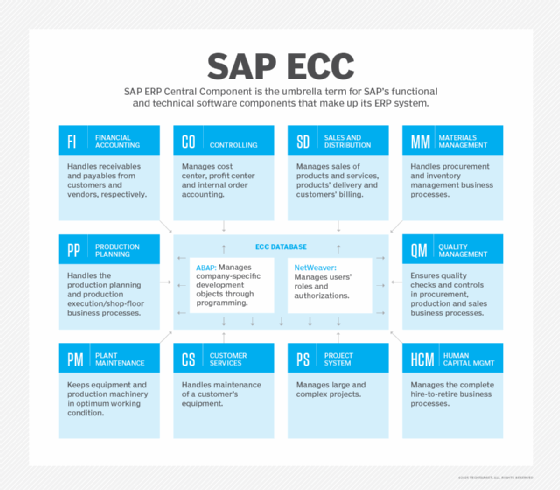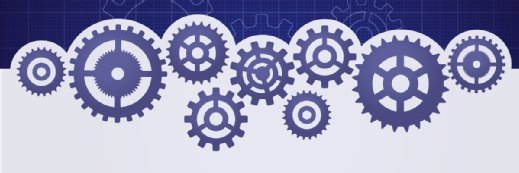What is SAP ERP?
SAP ERP is enterprise resource planning software developed by the company SAP SE. ERP software, in general, is modular software made with the goal of integrating the main functions of an organization's core business processes into a unified system.
An ERP system consists of software components called modules, each focusing on an essential business function, such as finance and accounting, human resources (HR), production, materials management or customer relationship management (CRM). ERP software helps organizations manage and automate these functions. Organizations generally only need to use select modules to run their particular business.
SAP ERP is a well-known ERP software suite that helps streamline business processes. SAP ERP, however, is now considered legacy software to many, as it has been superseded by SAP S/4HANA. SAP also actively promotes S/4HANA over ERP.
However, SAP will continue supporting existing SAP ERP customers until December 2027. After this, the company will no longer provide updates or security patches for older versions. In 2020, SAP extended the end of support deadline from 2025 to 2027 to give organizations time to migrate to SAP S/4HANA.
What does SAP stand for?
The original name for SAP as translated from German was System Analysis Program Development. The letters are pronounced individually. The "SE" in the full corporate name, SAP SE, stands for Societas Europaea, which is similar to the U.S. term, Inc.
SAP is a multinational software vendor and the market-share leader in ERP. The company currently serves more than 180 countries and offers on-premises, cloud and hybrid deployment models, though cloud computing options are the focus of most of its development efforts.
What is SAP ERP?
SAP's various ERP products enable its customers to run their business processes -- including accounting, sales, production, HR and finance -- in an integrated environment with data from each module stored in a central database. The close integration and common data store ensure that information flows from one SAP ERP component to another without redundant data entry and help enforce financial, process and legal controls.
The most widely installed SAP system, SAP ERP Central Component (SAP ECC), is an on-premises ERP system that's usually implemented in medium-sized and large companies.
At one time, the term SAP ERP was synonymous with ECC. The term has also been used as a catchall for all of SAP's ERP products, including ECC, S/4HANA, Business One and Business ByDesign.
ECC, which has been succeeded by S/4HANA, separates its modules into functional and technical modules. Functional modules include the following:
- Financial Accounting and Controlling (SAP FICO).
- Sales and Distribution (SAP SD).
- Materials Management (SAP MM).
- Production Planning (SAP PP).
- Quality Management (SAP QM).
- Plant Maintenance (SAP PM).
- Project System (SAP PS).
- Customer Service (CS).
- Human Capital Management (SAP HCM).

How does the SAP ERP system work?
As an on-premises ERP system, SAP ECC is typically deployed in a three-tier, client-server architecture. The three tiers are presentation, application and database.
The presentation tier provides the user with the SAP graphical user interface, which can be installed on any computer that uses Microsoft Windows or macOS. The SAP GUI is the point of communication between the user and ECC.
The application tier is the core of ECC. It processes transactions, executes business logic, runs reports, monitors database access, prints documents and communicates with other applications.
The database tier stores the records of transactions and other data.
Key SAP ERP features and capabilities
ECC is the ERP system at the center of SAP Business Suite, a broader collection of modules that handle other common business processes, such as supply chain management (SCM) and product lifecycle management (PLM).
Key features and modules of SAP ERP include analytics and reporting, financial accounting, HR management, materials management, product planning, sales and distribution and supply chain management.
S/4HANA is the vendor's in-memory ERP platform, released in 2015. It's an ambitious rewrite of the Business Suite optimized for the SAP HANA in-memory database platform. According to SAP, S/4HANA is meant to reduce complexity and replace SAP ECC.
SAP S/4HANA Cloud is a software as a service (SaaS) version of S/4HANA, providing the advantages of HANA's in-memory processing and real-time data accessibility within a subscription-based SaaS model.
SAP Business ByDesign is a SaaS ERP system originally marketed to small and midsize businesses. Today, it occupies the midmarket segment of the SAP product line. A fourth ERP product, SAP Business One, is geared toward smaller businesses and runs on-premises or in the cloud.
Advantages of SAP ERP
The main advantages of SAP ERP include the following:
- Standardizes an organization's business processes. SAP ERP helps improve consistency across departments, increasing an organization's efficiency. This increased level of visibility makes data from different departments more easily accessible.
- A unified view of the business. SAP ERP can provide an organization with more transparency across departments.
- Customizability. Organizations only use the ERP modules required to run their business.
- Strong reporting and analytics features. SAP ERP provides real-time data accessibility and analysis, enabling quick, actionable decisions.
Disadvantages of SAP ERP
SAP ERP does come with its downsides, however. These can include the following:
- High purchase and implementation costs. These costs include buying the software and the underlying infrastructure, labor costs of internal IT employees and external consultants, the costs of training employees and the residual costs of software maintenance and periodic upgrades.
- Complexity. Its complex structure means implementations could take several years.
- Customization. SAP ERP can be difficult to customize without the help of a third party or a technical expert with a deeper understanding of programming. The customization process could also be difficult for organizations that require specific software tailored to their needs.
SAP software and ERP use cases
SAP software helps organizations manage nearly every aspect of their business, from finances to HR, procurement and logistics.
Business Suite includes a wide range of business applications and industry-specific functionality. In addition to ECC, it includes modules for CRM, PLM, SCM and supplier relationship management.
The following industry-specific applications in Business Suite or S/4HANA offer functionality for these business requirements:
Consumer
- Agribusiness.
- Consumer products.
- Fashion.
- Life sciences.
- Retail.
- Wholesale distribution.
Discrete manufacturing
- Aerospace and defense.
- Automotive.
- High tech.
- Industrial manufacturing.
Energy and natural resources
- Building products.
- Chemicals.
- Mill products.
- Mining.
- Oil, gas and energy.
- Utilities.
Financial services
- Banking.
- Insurance.
Public services
- Defense and security.
- Federal and national government.
- Future cities.
- Healthcare.
- Higher education and research.
- Regional, state and local government.
Services
- Cargo transportation and logistics.
- Engineering, construction and operations.
- Media.
- Passenger travel and leisure.
- Professional services.
- Sports and entertainment.
- Telecommunications.
History of SAP
SAP was started in 1972 by five former IBM employees in Mannheim, Germany. The original idea for SAP was to enable customers to interact with a common corporate database for a comprehensive range of applications in real time.
In 1973, SAP released R/1, a financial accounting system. R/1 ran on IBM servers and disk operating systems, and it had a single-tier architecture in which presentation, applications and data were on one platform.
In 1979, SAP released R/2, a mainframe system that provided real-time data processing across accounting, manufacturing, supply chain and HR. R/2 used a two-tier architecture, with presentation on one platform and applications and data on another. R/2 helped power SAP's growth, and the vendor expanded its customer base to about 200 companies.
In 1992, SAP released R/3, which represented a switch from mainframe computing to the client-server model and from a two-tier to a three-tier architecture, in which presentation, applications and data were housed separately. R/3 was a critical product for SAP that launched the company onto the world stage.
In 2004, the company launched SAP NetWeaver, which received considerable industry attention as the first fully interoperable, web-based, cross-application platform for developing SAP applications and others. Also, in 2004, the successor to R/3, SAP ECC, was released.
In 2009, SAP Business Suite 7 became available to customers worldwide. This version used a service-oriented architecture.
In 2011, SAP launched SAP HANA, an in-memory database platform at the forefront of its current strategy. HANA was a major development project for SAP, which has said it intends HANA to replace the traditional databases it has used for its business applications.
In 2015, SAP released SAP S/4HANA, a successor to SAP ERP. SAP S/4HANA was built entirely off of SAP HANA's in-memory database. Compared to SAP ERP, SAP S/4HANA offers better performance, real-time analytics and more simplified processes.
Since 2020, SAP has focused on a cloud-first strategy, offering products like SAP S/4HANA Cloud and Rise with SAP. In 2023, SAP introduced artificial intelligence (AI) and machine learning technologies to its services.
Since 1996, SAP has also made more than 60 acquisitions. A major focus for the company in recent years has been building its cloud computing capabilities and enabling greater mobility. Some of the more prominent acquisitions include the following:
- 2024: WalkMe, digital adoption platforms.
- 2021: Signavio, business process management.
- 2018: Qualtrics, experience management; later spun out by SAP.
- 2018: CallidusCloud, sales team performance management.
- 2014: Concur Technologies, online travel and expense management SaaS; the largest acquisition to date.
- 2014: Fieldglass, cloud-based contingent labor and services.
- 2013: Hybris, e-commerce.
- 2012: Ariba, cloud-based B2B marketplace.
- 2011: SuccessFactors, SaaS HCM.
- 2007: BusinessObjects, business intelligence.
The future of SAP
By 2022, SAP was firmly focused on moving more customers to the cloud and S/4HANA and using both as platforms to deliver leading-edge technologies, especially AI, the internet of things (IoT), big data and advanced analytics. This is generally still SAP's sentiment today.
The broader vision is to help customers build the intelligent enterprise, a new kind of organization that takes advantage of AI, ubiquitous networking and more human-centric user experiences to become more adaptive, innovative and ultimately successful. At the same time, SAP leadership has said technology must be put to the service of a more environmentally sustainable world.
SAP will end support for SAP ECC by 2027. ECC, originally introduced in 2004, was a core component of ERP modules. With this gradual withdrawal from ERP, SAP is pushing S/4HANA, S/4HANA Cloud and Rise with SAP instead.
SAP has also mentioned integration with AI and IoT as a trend in ERP, as these technologies offer a range of benefits to data use in a business. It has also mentioned how AI-powered analytics and data visualization tools can replace ERP dashboards.
SAP will likely continue to promote its cloud-based ERP offerings and integrate technologies like AI, machine learning and IoT into its product offerings.
Eventually leaving SAP ERP in the past, SAP as a company will likely continue to push newer technologies. Learn more about how SAP is implementing AI strategies.






